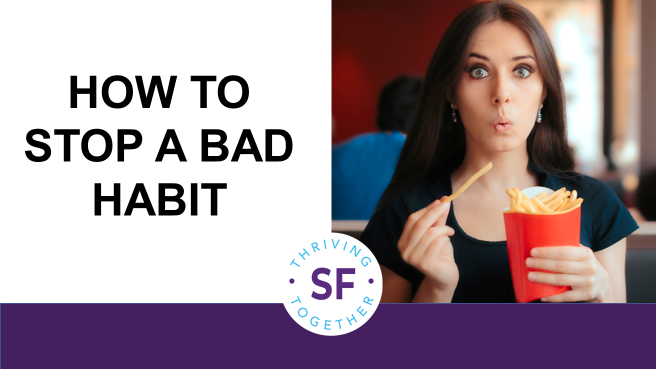Eliminating potato chips, sugar-filled soft drinks and cheesy comfort food seems like a logical plan if you need to lose weight. Reducing the time spent texting or rambling through social media feeds makes sense if you need to spend more time with family or on important goals. But your plan becomes even more challenging when you discover that you are being driven by a negative mindset to stop a behavior you enjoy or change a habitual routine.
Self-help advisors recommend replacing the negative approach with a more positive one: Instead of giving up a bad habit; adopt a good one. But a problem persists. Adopting a good habit to replace a bad one often demands an approach based on manufacturing motivation, devising discipline and generating more willpower. Ironically, industries dedicated to diets, incentive programs, and self-improvement have grown exponentially because people keep searching for answers with approaches that simply don’t work.
Most of our models for changing behavior are based on outdated, unproven or disproven theories about motivation. We’ve come to believe that generating motivation through rewards and incentives works; that discipline and willpower can prevail. Even when we desperately want to accomplish a goal such as weight loss or giving up a bad habit, we tend to succumb to a carrots-and-sticks approach (reward good behavior; punish negative behavior) developed in the 1940s based on animal research.
Give a pigeon a pellet and we can manipulate its behavior. Worked with pigeons, so it must work with people, right? Wrong.
After generations of using bribes and threats to achieve goals, we have come to realize an important truth: People are not pigeons. What if you recognized that you have alternatives to carrots (rewards, money, power, status, image) and sticks (shame, guilt, fear) or realized that when discipline and willpower are required to stop or change a habit, you’re moving in the wrong direction? What if you could take advantage of a different model of motivation to stop a bad habit?
Roland was a lifelong smoker. He grew up in North Carolina, the son of tobacco farmers. Smoking was a part of his life — he would have felt guilty if he didn’t smoke! Inevitably, his doctor gave him stern warnings to quit. He knew he should quit; the glaring warning on the cigarette package was a constant reminder.
He tried, but since he was burdened with an imposed outlook, his efforts were futile. He chewed stop-smoking gum; he wore a stop-smoking patch. But he continued to smoke, got horrible nausea, spit out the gum and pulled off the patch. He signed up for stop-smoking classes — and found himself grabbing a cigarette during the break. He quit (the class, not smoking). He heard about an acupuncture point on the ear that reduces cravings, so he had his ear pierced. Nothing worked.
One day, he was driving his car, smoking a cigarette, when his 3-year-old daughter cried out from the backseat, “Daddy, please quit smoking. You’re killing me back here!” It took a moment for her outcry to sink in, but when it did, Roland experienced an immediate shift. He realized that smoking violated two of his primary values: His daughter’s health and being a good role model. He put out the cigarette and never smoked again. Roland chose to love his daughter more than the cigarette.
Sharing Roland’s story over the years, I’ve had dozens of people share the same phenomenon: They were surprised how quickly they were able to give up a bad habit by making a values-based choice.
Empirical evidence and compelling motivation science support what Roland and others have experienced. You can come out of the dark ages and choose to be motivated at a higher level by proactively creating the three nutriments for optimal (and sustainable) motivation: choice, connection and competence.
Roland created choice by recognizing he had options — he could continue smoking and hurt his daughter or he could stop smoking and be the father and role model he longed to be. He created connection by acknowledging his profound love for his daughter. He created competence by acting on his love and deeply held values and. in the process, mastered his motivation to stop a bad habit he’d tried to give up for years.
When you practiced the skill of motivation by creating choice, connection and competence, you may discover a remarkable truth. You can stop a bad habit by simply choosing to love something you value more than you love the bad habit.
Susan Fowler is on a mission to help you learn the skill of motivation. In her latest book, “Master Your Motivation: Three Scientific Truths for Achieving Your Goals,” she presents an evolutionary idea: Motivation is a skill. Providing real-world examples and empirical evidence, Susan teaches you how to achieve your goals and flourish as you succeed. She is also the author of bylined articles, peer-reviewed research and eight books, including the best-selling “Self Leadership and The One Minute Manager” with Ken Blanchard and “Why Motivating People Doesn’t Work … And What Does: The New Science of Leading, Engaging, and Energizing.” Tens of thousands of people worldwide have learned from her ideas through training programs, such as the Self Leadership and Optimal Motivation product lines. For more information, visit SusanFowler.com.
If you enjoyed this article, sign up for SmartBrief’s free e-mails on leadership and career development, among SmartBrief’s more than 200 industry-focused newsletters.
